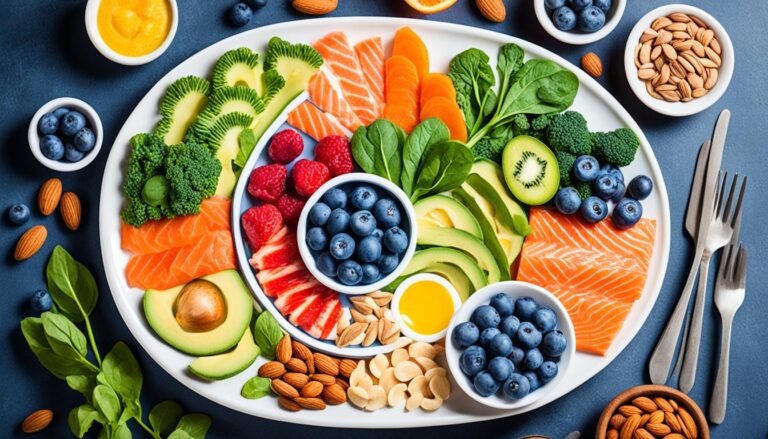Can a simple morning routine of 30 grams of protein and 30 minutes of low-intensity exercise be the key to successful weight loss and improved health? This approach, known as the 30/30/30 rule has gained popularity.
It’s believed to boost metabolism, increase energy levels, and support overall fitness and motivation. By adding this routine to your daily schedule, you may see big changes in your weight loss journey and overall health.
Key Takeaways
- The 30/30/30 rule involves eating 30 grams of protein within 30 minutes of waking up and then getting 30 minutes of low-intensity exercise.
- This routine can help keep you fuller for longer, reduce cravings, and increase daily calorie expenditure, contributing to weight loss and improved fitness.
- Consuming a high-protein breakfast has been linked to maintaining energy levels, decreasing energy intake at subsequent meals, and aiding in weight management by suppressing appetite.
- The 30/30/30 method may offer various health benefits, including weight loss and improved metabolic function, but its efficacy is not fully supported by scientific research.
- Individual factors beyond exercise timing can influence results, emphasizing the need for personalized approaches to diet and fitness protocols for optimal health and motivation.
- Finding joy in your chosen workout and allowing for flexibility in adherence can increase the likelihood of maintaining consistency in exercise routines and achieving your weight loss goals.
Understanding the 30/30/30 Rule for Weight Loss
The 30/30/30 rule is popular on social media, with millions following it. It focuses on three key points: eating 30 grams of protein at breakfast, eating within 30 minutes of waking, and doing 30 minutes of low-intensity exercise after breakfast. This method comes from Tim Ferriss’ book The 4-Hour Body, which suggests eating 30 grams of protein soon after waking.
Eating healthy food and exercising regularly are key for losing weight. The 30/30/30 rule helps start the day right by meeting exercise and protein goals early. Eating protein at breakfast can keep blood sugar stable, making you feel full longer and possibly eating less for fat loss.
The diet requires eating 30 grams of protein within 30 minutes of waking, followed by 30 minutes of steady state cardio. This can help meet exercise guidelines. Good protein sources include cottage cheese, Greek yogurt, eggs, chicken, tuna, salmon, chia seed pudding, protein shakes, and turkey and cheese roll-ups.
Breaking Down the Three Components
- Eating 30 grams of protein at breakfast
- Eating breakfast within 30 minutes of waking up
- Getting 30 minutes of low-intensity exercise after breakfast
By following the 30/30/30 rule and combining it with a healthy food diet and regular workout, you can reach your fat loss goals and live a healthy lifestyle.
The Science Behind 30 Grams of Protein
Eating 30 grams of protein at breakfast keeps you full longer. It also reduces cravings for snacks in the morning. This is key for healthy eating and weight loss motivation.
Protein boosts your metabolism and burns more calories. This helps with weight loss and improves health.
Research shows a big interest in the 30-30-30 method on TikTok. It involves eating 30 grams of protein in 30 minutes after waking. The Physical Activity Guidelines for Americans suggest 150 minutes of moderate exercise and two muscle-strengthening days a week. This can be done through exercise like steady-state cardio.
Some great high-protein breakfasts include:
- Eggs
- Lean meats
- Greek yogurt
- Nut butters
- Protein shakes
These foods help with feeling full, controlling blood sugar, and insulin resistance. They’re perfect for starting your day and helping with weight loss motivation and healthy eating goals.
By adding 30 grams of protein to your breakfast and exercising for 30 minutes, you’re ready for a healthy day. Stay consistent and adjust as needed to reach your goals.
| Breakfast Option | Protein Content |
|---|---|
| Eggs | 6-7 grams per egg |
| Lean meats | 20-30 grams per serving |
| Greek yogurt | 15-20 grams per serving |
Timing Your Morning Meal The 30 Minute Window
Eating breakfast within 30 minutes of waking up boosts your metabolism and energy. This short window helps control hunger and stops unhealthy snack cravings. A good morning meal gives you the fitness motivation to kick off your day.
A nutrition plan with protein, complex carbs, and healthy fats aids in weight loss and health. For those in the fit fam, a breakfast with 30 grams of protein keeps muscles strong and helps burn fat.
Here are some tips for timing your morning meal:
- Prepare your breakfast the night before to save time in the morning.
- Choose a quick and easy breakfast option, such as overnight oats or a protein shake.
- Listen to your body and adjust your meal timing based on your individual needs and schedule.
By following these tips, you can enhance your health and fitness. It also supports your weight loss goals. Stay consistent and make changes as needed for the best results.
| Morning Meal Option | Protein Content | Prep Time |
|---|---|---|
| Overnight Oats | 20-30 grams | 5-10 minutes |
| Protein Shake | 30-50 grams | 1-2 minutes |
| Scrambled Eggs | 18-22 grams | 5-10 minutes |
The Power of 30 Minutes Exercise
Regular physical activity is key for healthy living and wellness. The 30/30/30 rule suggests 30 minutes of light exercise after breakfast. This can boost calorie burn and aid in weight loss. It also helps lower the risk of chronic diseases.
Exercising for 30 minutes can make you feel better and live longer. Studies show that 90 minutes of moderate exercise a week can add years to your life. Daily 30-minute workouts for 8 weeks can also improve your health, like cholesterol levels and heart fitness.
For those into body building, adding exercise to your day can help reach your goals. Here are some perks of regular exercise:
- Increased muscle mass and strength
- Improved bone density
- Enhanced metabolic function

Adding 30 minutes of exercise to your day can bring many benefits. You’ll see better health, more muscle, and strength. Whether you’re aiming for healthy living, wellness, or body building, exercise is vital for a balanced life.
Metabolic Benefits and Fat Loss Potential
The 30/30/30 rule helps with weight loss and better body shape. It works by eating 30 grams of protein in the morning and doing 30 minutes of light exercise. This boosts your metabolism and burns more calories, helping you lose weight and get fitter.
Studies show that eating 30 grams of protein in the morning can lead to eating fewer calories at lunch. Starting your day with a high-protein breakfast makes you feel full longer. This can help you make healthier food choices and control your appetite, leading to better health.
The 30/30/30 method involves eating 30 grams of protein first thing in the morning. This can help you eat fewer calories all day. Research shows that eating more protein can help you lose weight faster, even if you’re eating the same number of calories.
Doing steady-state cardio, as recommended in the 30/30/30 method, also burns fat and improves health. It supports your fitness and overall health.
| Benefit | Description |
|---|---|
| Increased Metabolism | Boosts calorie burn and supports weight loss |
| Improved Body Composition | Helps reduce body fat and preserve lean muscle mass |
| Enhanced Fitness | Supports cardiovascular health and overall well-being |
The 30/30/30 rule is a great way to lose weight, get fit, and stay healthy. Its benefits make it a good choice for anyone looking to improve their well-being.
Creating Your 30/30/30 Meal Plan
To lose fat and eat healthy, you need a good meal plan. The 30/30/30 rule is key. It means eating 30 grams of protein within 30 minutes of waking up. Plus, do 30 minutes of light exercise.
This helps build lean body mass. It keeps you full and stops you from eating too much.
Your meal plan should have lots of different foods. This ensures you get all the nutrients you need. Good protein sources include probiotic cottage cheese, Greek yogurt with nuts and berries, protein shakes, bacon, chicken, and eggs.
Don’t forget to add fruits, veggies, and whole grains too. They’re all important for a balanced diet.

- Start with a high-protein breakfast to increase satisfaction for up to three hours
- Incorporate 30 minutes of low-intensity exercise to reduce blood pressure and increase satiety
- Aim for at least 150 minutes of moderate-intensity aerobic activity per week
Follow these tips and make a solid meal plan. This way, you can lose fat and stay healthy. Always choose healthy foods and stick to your plan for the best results.
Common Mistakes to Avoid
When following the 30/30/30 rule, it’s key to know common mistakes. These can slow down your progress and cause frustration. A good workout and diet plan is vital for lasting weight loss and better health. Adding healthy food to your meals helps keep you on track and avoids problems.
To get the most from the 30/30/30 rule, you must get your protein right, exercise hard enough, and time meals and workouts well. A balanced diet with many healthy food choices supports your workout and weight loss goals.
Protein Calculation Errors
One big mistake is not calculating protein correctly. This can mean you’re not getting enough nutrients and can slow down weight loss. Always talk to a healthcare expert or a registered dietitian to figure out how much protein you need.
Exercise Intensity Issues
Another error is exercising too hard or too soft. This can cause injuries or make you feel burnt out. It’s important to listen to your body and adjust your workout plan. Mix cardio, strength training, and flexibility exercises to boost your health and fitness.
Timing Misconceptions
Getting the timing wrong can also hold you back. Like eating protein at the wrong time or exercising too hard. By avoiding these mistakes and sticking to a balanced diet and workout plan, you can succeed with the 30/30/30 rule.
Combining the 30/30/30 Rule with Other Weight Loss Strategies
To get better results and stay healthy, mixing the 30/30/30 rule with other weight loss plans is key. A balanced diet is vital, giving your body the nutrition it needs. Adding strength training and high-intensity workouts can also boost your fitness motivation.
Being part of a fit fam can help too. Having family or friends support you can make losing weight more fun and lasting. Here are some strategies to think about:
- Eating a balanced and nutritious diet
- Incorporating strength training and high-intensity interval training
- Getting enough sleep and managing stress levels
By using these methods with the 30/30/30 rule, you can see better weight loss and health gains. Remember, everyone’s path is different. It’s important to find what works best for you.

| Strategy | Benefits |
|---|---|
| Balanced diet | Provides necessary nutrition for optimal functioning |
| Strength training | Boosts fitness motivation and increases muscle mass |
| High-intensity interval training | Improves cardiovascular health and increases calorie burn |
Tracking Progress and Maintaining Motivation
Tracking progress and staying motivated are key to healthy living and wellness goals. You can track weight loss, body fat percentage, and take progress photos. Celebrating small wins and rewarding yourself for milestones keeps motivation high.
For body building and weight loss, a balanced diet and regular exercise are crucial. The 30/30/30 rule is helpful, but it fits everyone differently. Getting advice from a nutritionist or fitness coach can tailor your plan to your needs.
Here are some ways to track progress and stay motivated:
- Set realistic and achievable goals
- Create a workout routine and stick to it
- Monitor progress with regular weigh-ins and body measurements
- Share progress with a friend or family member for accountability
By using these strategies and focusing on healthy living and wellness, you can boost your chances of success. This will help you reach your body building goals.
Adapting the Rule for Different Lifestyles
Starting your weight loss journey with the 30/30/30 rule? It’s key to make it fit your lifestyle. Whether you’re always on the go or love to travel, adjusting the rule is vital. This means tweaking your work hours, weekend plans, and travel to keep up with your health goals.
Busy professionals can save time by cooking meals ahead. Try making healthy meals on weekends or packing snacks for work. Also, adding exercise to your commute, like walking or biking, can boost your fitness.
Modifications for Work Schedules
- Schedule your 30 minutes of exercise during your lunch break
- Prepare healthy meals and snacks in advance
- Use a fitness app to track your progress and stay motivated
Weekends are a chance to keep your routine consistent. Plan healthy meals, schedule workouts, and get enough sleep. Simple changes can help you meet your fitness and weight loss goals.

Travel Considerations
Traveling can make sticking to the 30/30/30 rule tough. But, with some planning, you can stay on track. Pack healthy snacks, find local gyms, and plan meals ahead. Mindful eating and exercise can keep you on track, even when you’re away.
| Tips for Traveling | Benefits |
|---|---|
| Pack healthy snacks | Stay full and satisfied |
| Research local gyms or fitness studios | Stay active and motivated |
| Plan your meals in advance | Make healthy choices and avoid temptation |
By tailoring the 30/30/30 rule to your lifestyle, you can reach your health goals. Stay flexible, consistent, and choose healthy options for lasting success.
Conclusion Making the 30/30/30 Rule Work for You
The 30/30/30 rule is more than a weight loss plan. It’s a way to live a healthier life. Start your day with 30 grams of protein and 30 minutes of gentle exercise. This sets you up for a day of healthy eating, weight loss motivation, and good exercise habits.
Adapting to the rule might take time, but the benefits are huge. It can help you lose weight, boost your energy, control blood sugar, and improve your metabolism. True change comes from lasting lifestyle changes, not quick fixes. See the 30/30/30 rule as a guide to a better, happier you.





